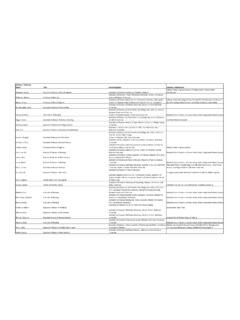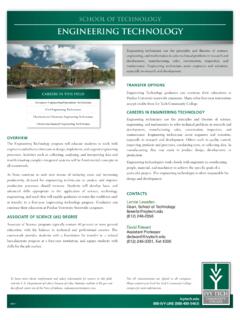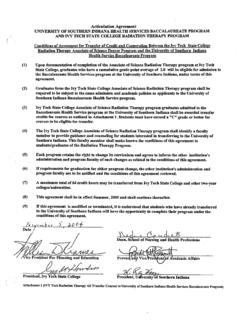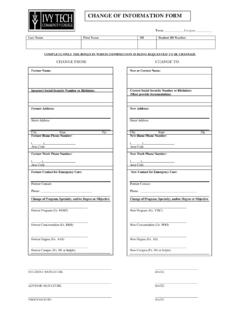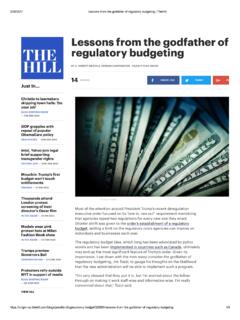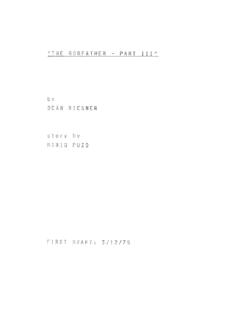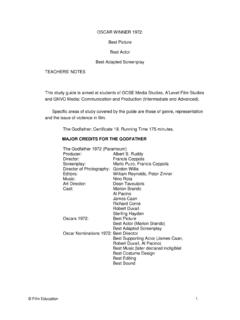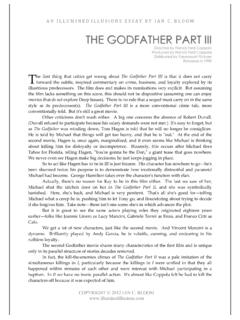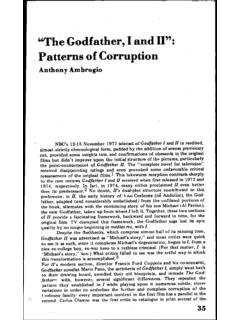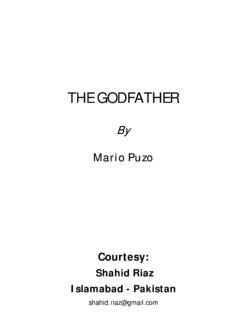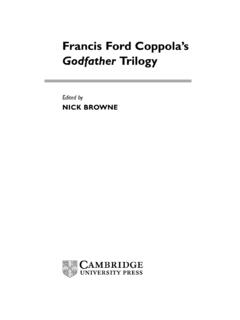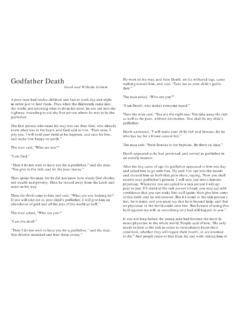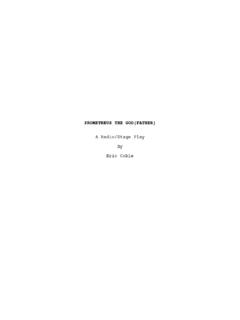Transcription of Writing an Art History Essay
1 1 Writing an Art History Essay An Essay is a short literary composition on a single topic that presents the views of the author. The French writer Michel de Montaigne (1533-1592) first popularized the form in his 1580 book Essais, which collected his thoughts on historical, philosophical, personal, and cultural matters. The French word essai, from which Essay is derived, literally translates to attempt or trial. Montaigne thought the Essay was a way to try to structure his thoughts in a meaningful, organized way, and each essai contains a specific claim about human nature and utilizes historical sources (such as ancient poets like Homer and ancient Greek and Roman philosophers) to strengthen his argument. At the college level, writers largely produce essays and not reports. A report is a mere collection of facts. If I asked you to write a book report, you d tell me who wrote it, what the plot of the book is, who the characters are, how it ends, etc.
2 Basically any of the factual elements about the book that prove that you have read it. If I asked you to write a report about Franklin Delano Roosevelt, you d tell me he was the 32nd president of the United States; that he served from 1933-1945; that he spearheaded help for the Great Depression and World War II; that he had polio as a young man, which left him largely bound to a wheel chair as an adult; that he was born in 1882; and so on and so on all objective facts that wouldn t change between anyone s report. An Essay , however, makes an argument your argument, to be exact. An Essay contains a central claim that you believe and allows you to demonstrate to the reader why such a belief is correct or at least logical by using facts and evidence and examples. essays show a writer s mind on the page, which is why it is a popular form of assessment in college-level coursework.
3 Argument seems at first like the audience and the writer are fighting over something not necessarily so. While it is possible to argue over something very controversial (whether the death penalty should be abolished, for instance), arguments are more traditionally defined as a claim supported by reasons. Anything that can be a claim ( , an interpretation about the meaning of a work of art) can be at heart of an Essay . Most Writing in art History involves formal analysis of at least one work of art. In other words, a student builds an interpretation (an argument) about an artwork and uses observations of that artwork to support her or his interpretation. For example, if I interpret a particular painting to mean that humans are becoming more and more isolated from each other as technology continues to advance, I will need to point to specific elements inside that painting that have led me to that interpretation.
4 Because interpretations are claims, we might disagree what a painting actually means; that s okay! The strength of an analysis is how well the writer can find evidence (observations) to support his or her view. At its most basic level, analysis is a kind of critical reading. Analysis is a common academic assignment because it encourages critical reading, necessitates critical thinking, and demonstrates to a professor that you have engaged with a text on its concrete level (the actual text itself) and its abstract level ( reading between the lines, conceptualizing the author s intentions). It is also a widely popular assignment because people use analysis every day; perhaps they don t use it in the same sense that a college requires its students to use it, but people examine, debate, select, and problem-solve each day. By weighing consequences and looking at the larger, deeper, more complete picture of something, a person is conducting analysis.
5 One popular topic for analysis is art. Think of the film The Godfather (1972). You ve probably seen it. It s widely considered to be one of the greatest films ever made, but why? Most people might say that it s a package deal meaning the film as a whole is simply great. But a critical reader knows something with so 2 many pieces, such as a film, can t just be great as a whole and leave it that. There are elements inside the film that contribute to its greatness. The goal of analysis is to identify what those elements are and explain why those elements make the film great. Let s say you ve been asked to write an analysis of The Godfather in which you discuss the relationship between business and family. To do this, we have to watch the movie very carefully and pick out all of the moments about business and family; then we add up these moments and determine what they mean.
6 So, The Godfather sets up two very different families the biological family (the blood-related Corleones) and the business family (The Corleone Family as a criminal syndicate). Those are related in important scenes, such as Vito taking requests at his daughter s wedding and Michael s final orchestration during his son s christening. Then the film sets up a relationship between a father (Vito) and his sons (Sonny, Fredo, and Michael). Vito is in many ways the film s hero; he s noble, balanced, reasonable, practical, but cutthroat when needed. He has a good balance of family and business. Sonny is so wildly imbalanced toward family that he can t run the business; Fredo is so focused on business success that he forfeits obligations to his biological family. Michael seems at first to have the same balance his father does, but the film suggests a darker current running through Michael, who won t be able to balance it like his father and whose downfall will be tragic.
7 And once you have the examples, you can draw a conclusion as to what they mean: The Godfather illustrates that finding a balance between business and family is crucially important, but only Vito Corleone seems to understand how to find this balance, as all three of his sons fail to live up to his example. This interpretation you reach is called your thesis statement, and it belongs at the start of your analysis paper. You want to let the reader know as early as possible what your interpretation is and how you re going to support it. The thesis statement here suggests that after a little bit of analysis, the story of The Godfather in addition to being a really awesome movie actually seems to mean something on a more complex level. We can appreciate the film in a deeper way, and that s what analysis is really all about. Often, art History papers will ask you to compare and contrast more than one artwork in formal or iconographic analysis.
8 Formal here doesn t mean elegant or fancy, but rather concerned with form line, color, texture, space; iconography refers to the way particular artworks use symbols and what those symbols mean. (An example of iconography would be a painting that depicts a naked woman in a garden with an apple and a snake. This is clearly a reference to Eve in the Genesis creation myth.) When you attempt to build a thesis statement that compares and contrasts works of art, there are two basic templates: The Unexpected Similarity. This type of interpretation says that while two (or more) artworks don t appear to have a lot in common, they actually share an unexpected and important similarity that the paper will bring to the surface for the reader to appreciate. For example: While X and Y are from different geographic regions and different eras of History , they both showcase the role that gender plays The Important Difference.
9 This type of interpretation says that while two (or more) artworks appear to have a lot in common, they actually possess an important difference that the paper will bring to the surface for the reader to appreciate. For example: While it may seem that X and Y each possess qualities associated with the Byzantium period, they actually possess an important difference in the way 3 TIPS AND TRICKS Here are some basic tips for Writing a good art History paper. Remember that you can always consult a tutoring lab or your professor in order to answer additional questions you may have. An analysis not merely description. Every time you describe something about the artwork in the body of the Essay , you should explain why that particular aspect is noteworthy. This is the distinction between the WHAT and the WHY: what did you notice about the artwork, and why is it important?
10 An academic paper needs structure. Move from discussing larger elements (such as the effect of the composition of a work) to discussing the specific details (such as the effect of the brushstrokes). Each paragraph should be about something specific and not consist of mere observations. Use the introduction to give a brief description and overview of the works. Assume your reader is educated and open to your interpretation, but do not take it for granted that your reader is intimately familiar with the work. A good test to tell if you ve described something well enough is to imagine giving a friend your written analysis and determining whether she or he would be able to sketch the artwork briefly or pick it out of a line-up. Introductory paragraphs should include the name of the work, the title, the subject, the artist s full name, the date, the period, the country.
